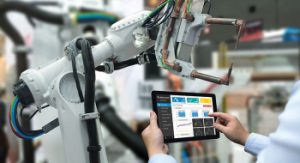
Unlocking Industry 4.0 in the age of IoT and 5G
There are many reasons to be excited about the future of IoT and 5G. The industrial sector has been one of the most active players in this space, with manufacturers looking to leverage these technologies to improve efficiency, reduce costs and improve safety. In fact, according to a recent report from Bloor Research, 5G will be essential on the path towards Industry 4.0 — a future where smart factories optimize production processes by using real-time data from connected devices in order to make more informed decisions. Wireless connectivity is making all of this possible. As in other sectors, IoT related to manufacturing are made possible by wireless connectivity and the technologies that support it. Today, IoT relies on low power and long range wireless connections like NB (Narrowband) standard which can support a variety of IoT use cases including event detectors, smart trash bins and smart metering. Industrial applications include asset tracking, logistics tracking as well as machine monitoring and more. Insight into production asset One of the key capabilities of IoT is asset tracking, or the ability to easily locate and monitor key components of a production facility. In the (near) future, companies will be able to automatically track parts as they move through the assembly process using smart sensors. Plant managers will also gain a real-time view of production output by connecting tools used by operators with any machines used in production. Through Industry 4.0 manufacturing with the use of IoT-generated data, manufacturers will have the within plants to quickly identify and resolve bottlenecks through the use of dashboards, which will help to lead to faster, higher quality production. Raising the bar for product quality Imagine how the continuous monitoring of products through the building cycle, made possible by having environmental sensors send back data about conditions critical for high quality, could help manufacturers improve the quality goods they produce. Sensors could be used to alert shop supervisors whenever quality thresholds are reached or when conditions such as air temperature or humidity are not optimal for production of specific items, like foods or pharmaceuticals.They could also be used to monitor equipment performance, give real time feedback on machine capacities and alert managers when maintenance is needed before problems occur.
Supply Chain Management and Optimization
IoT technology offers manufacturers many benefits for managing their supply chains. They can use sensors to track and monitor inventories as they move from location to location throughout the chain. That includes shipments of supplies used in making products, as well as the delivery of finished goods.
Manufacturers could also gain increased visibility into product inventories to provide more accurate schedules for the availability of materials and shipment of products to customers. Analysis of this data could help companies make improvements in logistics by allowing them to pinpoint problem areas in the supply chain.
Sensors could be used to alert shop supervisors whenever quality thresholds are reached or when conditions such as air temperature or humidity are not optimal for production of specific items, like foods or pharmaceuticals.They could also be used to monitor equipment performance, give real time feedback on machine capacities and alert managers when maintenance is needed before problems occur.
Supply Chain Management and Optimization
IoT technology offers manufacturers many benefits for managing their supply chains. They can use sensors to track and monitor inventories as they move from location to location throughout the chain. That includes shipments of supplies used in making products, as well as the delivery of finished goods.
Manufacturers could also gain increased visibility into product inventories to provide more accurate schedules for the availability of materials and shipment of products to customers. Analysis of this data could help companies make improvements in logistics by allowing them to pinpoint problem areas in the supply chain.
In SYNDES TECHNOLOGIES Your Security Is Our Priority.
Sorry, the comment form is closed at this time.






